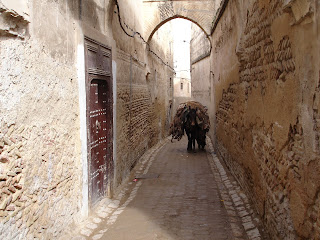

As Max has recounted, we moved to the Palais Jamai, but not without incident. When I asked to be checked out at the Riad Arabesque, they gave me the bill for our two meals (the room was prepaid), which I paid. Later, in the Palais, I saw they had added our two meals together and come up with a sum lower than either of the 2 parts. Almost immediately the phone rings - it's Abdul in the lobby, asking me to see him as there was a mistake in the bill. He insists the only way to resolve the problem is to return to the Riad. I'm pissed off and lecture the poor guy all the way back to the riad. Once we get there, it is obvious I didn't really have to return at all, as they had my credit card info on file. I lecture again. When I had originally asked to be checked out, they just sat there. I assumed they had asked a clerk or the manager to check us out, and I paced for at least 20 minutes while they just sat there and watched. Finally, I asked again how long it would be before we were checked out and they sprang into action - they didn't understand me the first time.
We reserve a room at the Jamai and the desk Mgr. tries to get us in touch with Air Royal Maroc to see if we could get an earlier flight home. No luck, he is told, we must go to the airport to get the tickets changed. We take a taxi to the airport, where the TICKET AGENT tells us he isn't authorized to change our ticket, we must go to the Air Royal Maroc office in Fez, about 2 miles from our hotel. Our taxi driver is very sympathetic and takes us to the office, which is closed because (wait for it) it's Sunday. Now here's my problem: Morocco is a Muslim country - their Holy Day is Friday, but remain open. But they're closed on Sunday. Which the ticket agent could have told us.
We give up and return to the Palais Jamai, a wonderful hotel.
The next day, we repack everything and head out for our last day on this fantastic trip. We (I) decide we should try doing short trips out from the hotel into the Medina, rather than getting another guide. Max gives in to my plan after officially going on record that it's a dumb idea. As it turns out, it's a dumb idea. During our initial forays, a persistent guy tries to get hired as a guide and becomes annoying. When we finally do hire a guide, it's one of the young men who originally helped us carry our bags to the Riad Arabesque when we first arrived - Muhammed.
For the next few hours, he takes us around the Medina, even taking us into a riad being renovated for a rich investor. The weather is perfect and we return to the PJ for a great late lunch and to get ready for our trip home. HOME!
The next morning we are awake at 4AM for a 5AM trip to the airport. Not too much of interest at the Fez Airport, but then we get to Casablanca and have 4 hours to kill. While wandering around the airport we pass an intransit lounge wherein we see scores of Moroccans and other regionals sleeping and basically living in an area of about 100 feet sqare. It stinks.
We end up going through security about 3 times and at one point are transferred to another terminal where we are given free coffee and cookies, except the cookies have an ant roaming over them. When it's finally time to board, it's about an hour before takeoff, but we soon see why the early start - they go through evreryone's carry-on luggage and do a body scan before letting you get on yet another bus to get to the plane. But we suffer through all of this, driven by the thoughts of getting home after 33 days on the road.







































